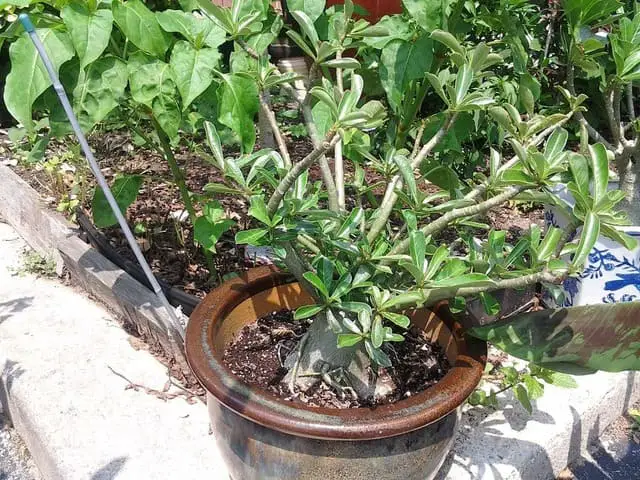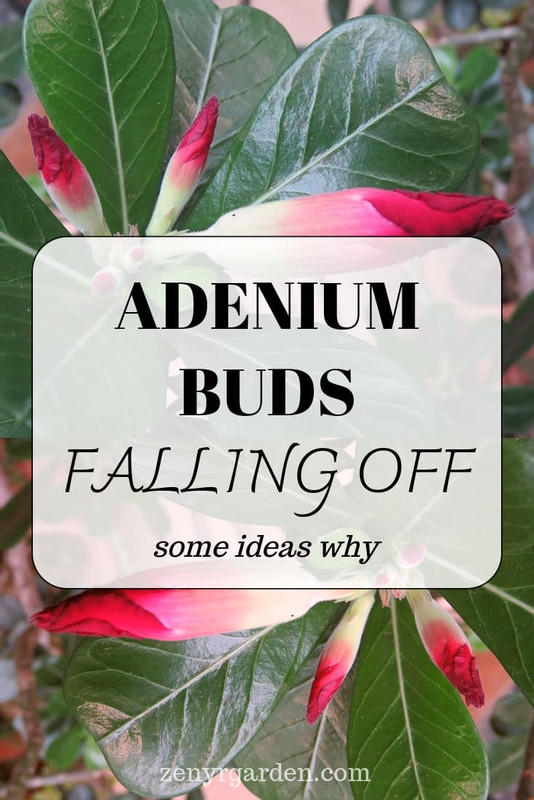Adenium buds dropping off may be caused by pests & insects. Sometimes, the acid in rainwater may damage the young buds. Without sufficient potassium, the plants may also abort the flowering process. Let's see some possible reasons why.
#1. Pests & Insects
Yellow Flies
The yellow flies are the most common insect that could affect the adenium buds. If you spot a tiny bite on the flower bud, it may be that these guys have been messing around.
When this happens, the flower bud will slowly droop down and become strangely curled up. The flies suck the nutrients out of the flower buds, which may cause them to fall off.
These guys are hard to catch in action because they appear late at night & very early in the morning.
One way to catch them is to use a fly trap. If you have about 30-40 adenium plants, then placing 2 fly traps would be enough. Because if there are too many traps, it may attract other flies to the yard, which we may not want.
The second bad guy causing bud dropping may be:
Mealybugs
You'll often see the little white mealybugs appear symbiotically with ants. The ants help carry the mealybug eggs and find good places for them to eat and reproduce on the plant, while the mealybugs give the ants back some sweet honeydew.
When mealybugs come visit the adenium buds, you may see the inside of the bud get very curved up. Like the yellow flies, they suck the nutrients from the buds, which make the buds go weak and eventually drop off.
So one way to say goodbye to them is to spray the ants. For a strong measure, you could use some ant sprayer. Alternatively, you could try spraying water around the adenium with a very high-pressure hose.
This may 'piss off' the bugs as it signals to them that with such frequent disturbance (or "earthquakes & tsunamis") this may not be a good place to stay and lay eggs. One grower uses beer + water to spray. You could try it if you like. It's good for the adenium plants, for our health and effective to keep these guys away.
One little note:
If You're Spraying Pesticide or Fungicide
If you spray pesticide or fungicide directly on the flower buds, chances are they may get burned and fall off very soon. This has happened to a lot of growers. Especially if you're spraying when the temperature is high. The leaves may also get burned.
So if you're using some of this stuff, spray it when the weather is cool like in early morning or late afternoon. Avoid spraying directly on the flower buds. It will help keep the buds alive.
Secondly, we might look at the aspect of:
#2. Rain
In some areas, the acidity in rainwater may damage the young buds. With the high nitrogen in the rain, the adenium plants may opportunistically take the chance to build up more branches. This could lead to what people call a bud abortion where the mother plants stop nourishing the buds, which could make them go wilted and drop after some time.
If you see that there are some branches shooting up next to the flowering point/cluster, it may be that the plants are still growing so strong that they want to shoot out more branches. Some call this "overshoot". It may also be the extra nitrogen in the soil or in the air during the rainy season (as adenium can also absorb the nutrients through their leaves).
In these cases, if there are not too many adenium plants, you could move them under a shelter to keep them safe from the rain. Or if there are too many adenium plants, you could set up a clear cover for them.
If the plants have been caught in the rain, use some fresh water or tap water to spray the rain (and its components dirt, dust, etc) off the buds. During the flowering stage, don't put too much nitrogen in the soil. It will help the plants focus their energy on flowering and not branching out.
Another possible aspect could be:
#3. Potassium
Sometimes, without sufficient energy the adenium may not be able to nourish their buds, which may cause bud dropping. During the flowering stage, you could ramp up the potassium amount. It helps with nice flowers and colors. Be careful not to add too much though. Because too much of it may burn the buds and leaves.
For Strong Buds & Flowers
If you notice the adenium buds keep turning dark and fall off after very good care, it may be the variety's current health. This may happen when buyers get the plants from nurseries that have used too much chemicals on the plants.
Or it could be so after many cloned generations which could weaken the plants' health or natural resistance. One way to handle this is to flush out any possibly affecting substance inside using sand as a substrate.
Some growers dig the plant up. Cut back some branches and dry it for about 2 hours. Then, let the plant rest for 7-10 days. After that, replant the adenium in sand. Keep watering when the medium is dry and let it enjoy some sunlight. Use no strong chemicals or pesticides at this point. Let it heal, let the flow do its job.
Then when you're confident the plant has gotten better, you can start feeding it with the good food that you know it'll like. And so hopefully, the adenium will give strong buds the next time it flowers.
Hope this post has given you some ideas for stronger buds and flowers. Have a good time growing your adenium & See you next time!
Responses to Readers' Questions
Perché il mio adenium che ho da tre anni non è mai fiorito? (Why has my adenium that I have had for three years never blossomed?)
--> Thanks for your question. What is the type of adenium you are having? Some adenium like dwarf DHA may take 3 years or more to flower. Make sure to give it enough sunlight (6-8 hours a day). It may help in blooming. I hope this helps!
You can check out this post for more details if you like. It talks about why the adenium may not be flowering yet:

Share or pin this post!



